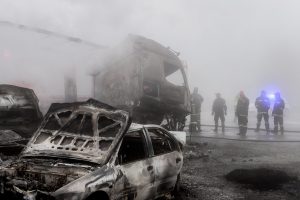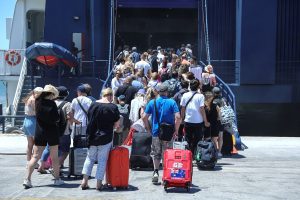It’s my marriage that sometimes hits turbulence on long-distance flights.
Last November, my husband and I were on a Turkish Airlines flight heading back from the Maldives when I heard the pilot’s voice overhead.
“Is there a medical doctor on board? Please identify yourself.”
My hand shot up in the air. I’m not a doctor; I’m a reporter. But my husband is a semiretired heart surgeon. At that moment, he was curled up under a blanket, sound asleep. I jostled him awake and he looked annoyed.
This marked the third time I had volunteered him as a doctor on a flight. “I figured there must be another doctor on the plane who is much more trained in the type of problems that come up on flights,” he says by way of explaining his initial annoyance. “It’s unlikely the passenger needs heart surgery.”
But once I volunteered him, he had no choice. He disappeared down the aisle with the flight attendant and was gone for more than an hour, leaving me in suspense.
Little room to move
Doctors board flights just like the rest of us, planning to watch movies, read, work or sleep. Yet they are frequently called to evaluate passengers with unknown medical emergencies. While many doctors (or their flight companions) feel morally obligated to volunteer, they often face highly uncomfortable situations, trying to diagnose outside their specialty, with limited equipment—in tiny spaces at high altitudes.
The number of global flights is expected to reach four billion this year, according to the International Air Transport Association. Medical emergencies happen on about 1 in 604 flights, according to the Centers for Disease Control and Prevention, but its recent report on air travel says the total is likely to rise with more people traveling and a greater percentage of older travelers.
Volunteer doctors show up in almost half of in-flight medical emergencies, according to the CDC. The most common incidents are fainting, in 37% of cases, respiratory symptoms, 12%, nausea or vomiting, 10%, cardiac symptoms, 8%, and seizures, 6%. A death on a flight is rare, reported in 0.3% of emergencies, and the majority were due to heart conditions.
Some doctors concede they don’t volunteer, fearing legal liability, although the Aviation Medical Assistance Act provides some protection for healthcare professionals acting as Good Samaritans. Laws vary by country, however.
In the event of a medical emergency, flight attendants typically take over, and the Federal Aviation Administration requires they have training for medical events. It also regulates the contents of emergency medical kits and requires automatic external defibrillators on most commercial flights.
Airlines also rely heavily on services that provide consults with emergency doctors on the ground, using satellite phones, cockpit radios, and apps on tablets and phones. MedAire, based in Phoenix, says it works with more than 100 airlines and had 52,407 medical calls from commercial flights last year.
“The medical volunteer should understand that they aren’t in charge and they aren’t alone,” says Dr. Thomas J. Doyle, the medical director for STAT-MD, which provides emergency doctors from the University of Pittsburgh Department of Emergency Medicine. “Physicians will think, I’m here, I have to be in charge of this.” But he says, “it’s usually the first time and 180 degrees from whatever their specialty is. They were going on vacation.”
Irregular heartbeat
On our Maldives trip, the flight attendant led my husband to a slender man with short gray hair, standing in the galley with two flight attendants. He was complaining of chest pressure. He said he had been diagnosed with an irregular heartbeat and forgot to take his medication that morning. My husband took his pulse and felt the extra heartbeats.
The flight attendant presented a large case of assorted medications—all labeled in Turkish. “I thought, ‘Oh, s—,’ ” says my husband, who tried to decipher the generic names in tiny print. He wanted a beta blocker to calm the patient’s anxiety and help with what he thought were premature ventricular contractions.
Another flight attendant began to translate, using Google. “We have aspirin,” he said, and my husband agreed that would be all right.
At that moment, a cardiologist appeared. “No, let’s not give him aspirin right now,” she said. (She was the ideal specialist since cardiologists diagnose heart symptoms. My husband was thrilled to have her take over.)
“Does anyone have an Apple watch?” she called out. A flight attendant produced the latest model, and the cardiologist used it to view the passenger’s EKG pattern, which showed he was indeed having premature ventricular contractions. She and my husband gave the passenger medication and reassured him.
What if the passenger dies?
Finding the right medical specialty on board is a roll of the dice. MedAire says its doctors have worked with volunteer ophthalmologists, psychiatrists and even veterinarians.
Bonnie Flannigan and her husband, both Los Angeles radiologists, were recently flying back from Ireland when she heard the call. “I was thinking, ‘Oh, my God, I’m a radiologist, what can I do?’ ” she says. She stood up in the aisle and was relieved to see that a group of volunteers had assembled. She went back to sleep.
“What if you do something that isn’t totally accepted and the passenger ends up dying?” she says.
Another issue: Volunteer doctors don’t always agree with each other or with the support doctors on the ground.
Scott Christensen, a medical oncologist used to treating cancer, was returning home to Sacramento from Hawaii a few years ago when he heard the “dreaded words” overhead. An older man had collapsed in the aisle.
“Pandemonium ensued,” says Christensen.
He, a family practitioner, an obstetrics and gynecological nurse, and three paramedics all rushed to the aisle.
“I just got dizzy and weak,” the man said. Christensen, who was kneeling in the aisle at the man’s head, learned the passenger had been ill with diarrhea and hadn’t kept up with his hydration.
Meanwhile, the flight attendant had reached a ground-based doctor on a phone. “They said, ‘We’ll tell you what to do,’ ” Christensen recalls. The doctor on the ground seemed worried about a possible neck injury and wanted more assessment.
“I’m on the scene and you’re not,” Christensen told the land-based doctor. He could see that the man wasn’t in pain and could move easily. “I didn’t find it that helpful,” he says. “They’re on the ground and we’re in the middle of the Pacific Ocean.”
An ambulance met the plane at the gate and the passenger was taken off on a gurney. “He was fine,” says Christensen.
The decision on whether to land the plane in a medical emergency is always up to the pilot who has to consider many factors including fuel and the ability to land safely.
Trained for emergencies
Emergency-room doctors, if present, often take the lead. Dr. Calvin D. Sun, a New York emergency doctor, says, “It’s surprising to hear from my colleagues how many doctors don’t volunteer. I volunteer every time. I am more comfortable with the uncomfortable.”
Sun was on a flight from Zurich to New York, watching “Captain America: The Winter Soldier,” when he heard the call. He and a surgical nurse found a woman in her 30s having cramps and abdominal pain. She didn’t speak English but her husband said she was in her 14 undefined week of pregnancy. The plane was over the ocean, with no place to land.
At some point, the woman began to bleed heavily. Sun moved her to a bathroom for privacy and started an IV. The nurse tracked the woman’s vital signs, which showed she was going into shock.
The pilot appeared at the bathroom door, and Sun says he told the pilot that the woman would likely need a blood transfusion and he needed to find someplace to land. Not long after, the plane landed in Halifax, Nova Scotia, with emergency vehicles on the tarmac. Sun says he was covered in blood and he changed into a pair of pajamas provided by the flight attendants. The other passengers surprised him with a lengthy round of applause after landing in Newark, N.J., and again at customs and baggage claim, which made him tear up.
In a serious emergency, the kitchen galley of a plane may become an intensive-care unit.
Dr. Jim French, a recently retired cardiologist in Rancho Palos Verdes, Calif., was happily watching a movie on a flight returning home from Amsterdam, when his wife, Sue, a nurse, nudged him.
“Did you hear that? They’re calling for medical personnel,” she said.
A flight attendant led him to an anxious middle-aged man who was sitting in a jump seat, short of breath and in distress. He learned the man had chest pain before boarding and used the plane’s medical kit to alleviate the symptoms.
French, though, told the pilot that the man needed to be hospitalized, and quickly. But there weren’t any airports with medical facilities nearby where they could land.
As he was checking the patient, French says, the man “slumped forward and became unresponsive without a detectable pulse.” French laid him on the galley floor, opened the man’s shirt, and applied the defibrillator. He started an intravenous line, hanging the bag of fluid from a coffee cart.
For the next two hours, French remained on his hands and knees in the galley, monitoring his patient as the plane diverted to Winnipeg, Manitoba. The flight crew started to serve the meals and beverages, but they had to step around the patient, the doctor and the medical equipment.
When French last saw him in Winnipeg, the man “was comfortable and looked outwardly good.” His wife, who had been in tears, gestured her thanks.
The plane took off for Los Angeles and a grateful flight attendant offered French a drink. He told her he just wanted to finish his movie.
Kathleen Hughes is a writer in Los Angeles. She can be reached at reports@wsj.com .



